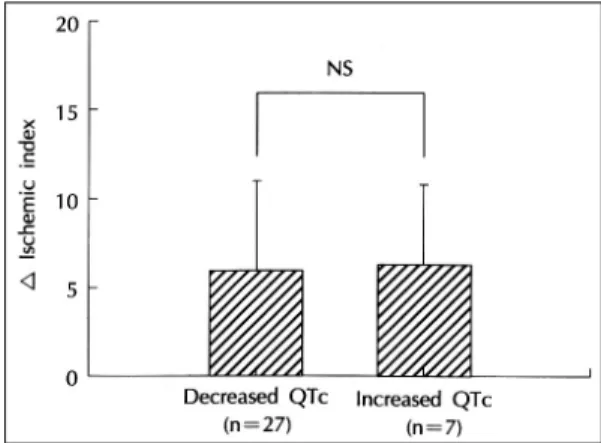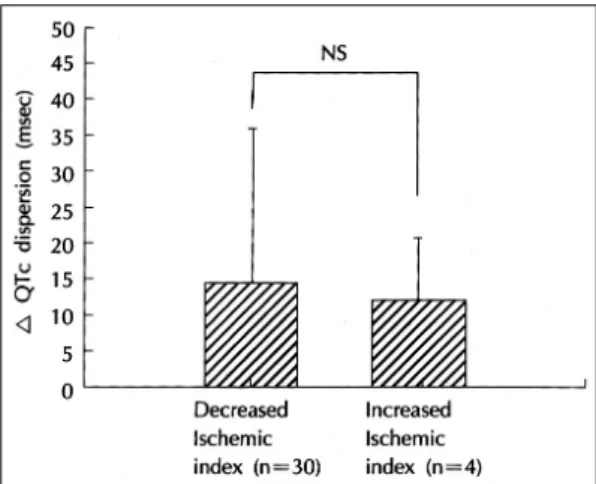Original Articles Korean Circulation J 2000;;;;30((((8))))::::998-1003
관동맥 재개통 후 QTc간격분산의 감소:정량적으로 측정한 심근 허혈의 호전 정도와의 연관성
울산대학교 의과대학 서울중앙병원 내과학교실,
1핵의학교실
2박상선
1
·최기준1
·남기병1
·이철환1
·홍명기1
박성욱1
·박승정1
·신중우2
·문대혁2
·김유호1
Decreased QTc Dispersion after Coronary Revascularization: : : :Relationships with the Quantitative Degree of Improvement in Myocardial Ischemia
Sang-Sun Park, MD
1, Gi-Byoung Nam, MD
1, Kee-Joon Choi, MD
1, Cheol-Whan Lee, MD
1, Myeong-Ki Hong, MD
1, Seong-Wook Park, MD
1, Seung-Jung Park, MD
1,
Jung-Woo Shin, MD
2, Dae-Hyuk Moon, MD
2and You-Ho Kim, MD
11
Department of Internal Medicine,
2Nuclear Medicine, Asan Medical Center, Ulsan University, College of Medicine, Seoul, Korea
ABSTRACT
Object and Methods: : : :Thirty-four patients (mean age:58.1±8.3 years, M:F=21:13) with angina in the absence of previous myocardial infarction, who underwent percutaneous coronary intervention (stenting and/or balloon PTCA, n=25) or coronary arterial bypass grafting (CABG, n=9) were evaluated to assess the relations- hips between the degree of improvement in myocardial dipyridamole Tl-201 SPECT and the degree of decrease in QTc dispersion after coronary revascularization. QTc dispersions were measured manually using digitizer by a single observer from ECGs printed at 25 mm/sec, 1 day before, immediately, 1 day, and 1 month after the revasc- ularization procedure. Myocardial Tl-201 SPECTs were performed before and 1 month after the revascularization and ischemic indices were measured in all cases. Results: : :Mean QTc dispersion was 51.4±17.0 msec before : revascularization, 42.6±15.1 msec immediately after, 45.6±19.3 msec 1 day after and 37.4±11.6 msec 1 month after revascularization. The decrease of QTc dispersion immediate (p=0.001) and 1 month (p<0.001) after revascularization, were statistically significant. Mean Tl-201 SPECT ischemic index measured before the revascularization (7.8±5.9) was significantly higher (p<0.001) than the one measured 1 month after the revascu- larization (1.5±2.8). But, in Δischemic index (ischemic index before revascularization– ischemic index 1 month afer revascularization), there was no significant difference between the patients with decrease in QTc dispersion after revascularization (6.2±6.3, n=27) and the patients without decrease in QTc dispersion (6.6±5.2, n=7).
There was no statistically significant correlation between ΔQTc (QTc dispersion before revascularization– QTc dispersion 1 month afer revascularization) and Δischemic index in total subjects. Conclusion: : : :QTc dispersions decrease after successful coronary revascularizations in patients with angina, but considering the relationships between the changes of QTc dispersions and ischemic indices in myocardial dipyridamole Tl-201 SPECT, the degree of decrease in QTc dispersion after coronary revascularization does not have the relationships with the quantitative degree of improvement in myocardial ischemia. ((((Korean Circulation J 2000;30((((8)))):998-1003)))) KEY WORDS:QTc dispersion·Coronary revascularization·Tl-201 SPECT.
논문접수일:2000년 3월 6일 심사완료일:2000년 7월 15일
교신저자:김유호, 138-736 서울 송파구 풍납동 388-1 울산대학교 의과대학 서울중앙병원 내과학교실 전화:(02) 2224-3150・전송:(02) 486-5918 E-mail:youho@www.amc.seoul.kr
서 론
1985년 Mirvis
1)는 급성 심근경색 24시간후의 환자 에서 흉벽에서의 유도위치에 따라 QT간격의 차이가 있음을 보고하였다. 이후 여러 연구
2-6)에서 표준 12유 도심전도상 측정될 수 있는 유도간 QT간격 차이의 정 도, 즉 QT간격분산은 심실 재분극의 국소적인 차이를 반영하고 QT간격분산의 증가가 심각한 심실부정맥 발 생위험과 관련됨이 제시되었다. 또한 이는 급성 심근경 색증,
7-9)좌심실비후,
10)만성 심부전,
11)확장형 심근병 증,
12)비후성 심근병증
13)14)및 변이형 협심증
15)에서도 동반되며, 항부정맥제들의 치료효과를 판정하는 지표로 서의 QT간격분산의 역할
3)6)16-18)도 보고되었다. 관동 맥질환을 가진 사람에서 심방조율로 유도된 심근허혈이 QT간격분산 증가를 보임이 기술되었고,
19)20)Tarabey 등
21)은 관동맥내 풍선으로 2분간 심근허혈을 유도, 특 히 ST분절의 상승을 보인 경우에서 QT간격분산의 증 가가 더 현저하였음을 보고하였으며, de Bruyne 등
8)은 노인에 있어 QT간격분산의 증가는 심인성 사망의 중 요한 예측인자라고 하였다.
많은 연구에서
22-26)관동맥성형술이 QT간격분산을 의미있게 호전시킨다고 발표하였고, 특히 Yunus 등
23)은 관동맥성형술 후 감소되었던 QT간격분산의 재증가 가 관동맥 재협착을 암시할 수도 있음을 제시하였다.
본 연구에서는 관동맥 재개술 후 QT간격분산을 연속 측정하고 관동맥 재개술 전후로 심근 관류스캔을 시행, 허혈의 정도를 정량화하여 이들의 변화 및 관계를 알아 보고자 하였다.
대상 및 방법
1998년7월부터 10월까지 서울중앙병원 심장내과에 입원하여 관동맥 재개술을 시행받은 협심증 환자 중, 심근경색증의 병력이 없고, 동율동을 보이며, QRS폭이 120 msec미만이고, 재개술 전 심전도상 8개 이상의 유도에서 QT간격의 측정이 가능한 34명의 환자를 대 상으로 하였다. 34예 중 25예는 경피관동맥중재술(ba- lloon PTCA and/or stenting)을, 9예는 관동맥 우회
로술(coronary arterial bypass grafting, CABG)을 시행받았다.
관동맥 재개술 전, 재개술 직후, 재개술 24시간 후 및 1개월 후 표준12유도심전도를 기록하였다. QT간격 의 측정은 25 mm/sec의 속도로 기록한 심전도에서 컴 퓨터화한 digitizer(UD-1212R graphic tablet, Wacom, USA)를 이용하여 한명의 관찰자에 의하여 측정되었다.
QT간격분산은 한 장의 12유도표면심전도에서 최대 QT 간격(msec)에서 최소 QT간격(msec)을 뺀 값으로 하 였고, T파의 종점은 T파가 TP 기저선으로 들어오는 점 으로 하였으며 U파가 있는 경우는 T파와 U파 사이의 최저점으로 하였고,
2)6)27-31)종점이 애매한 경우는 대상 유도에서 제외시켰다. QTc간격분산(corrected QT di- spersion, QTc)은 Bazett 공식(QTc(msec)=QT(ms- ec)/RR(sec))을 이용하여 구하였다.
32)관동맥 재개술 전 및 1개월 후 심전도를 기록한 동일 한 날에 심근 디피리다몰 부하 Tl-201 SPECT를 시행 하였는데 금식 후 다음날 아침 디피리다몰 0.56 mg/kg 을 4분에 걸쳐 정주하고 다시 3분 후 111 MBq(3 mCi) 의 Tl-201을 정주하였다. 부하영상은 Tl-201 정주 3 분 후, 재분포영상은 4시간 휴식 후 촬영하였다. 심근허 혈을 정량화하기 위한 허혈지수(ischemic index)는 부 하 및 재분포영상의 황소눈(Bull’s eye) 극성지도를 이용하였다. 극성지도를 심첨부, 전벽, 중격, 하벽 및 측벽으로 나눈 다음 심첨부를 제외한 나머지 부위를 다 시 심첨부와 기저부로 나누어 총 9개 분절에서 상대적 Tl-201 섭취율을 구하였다. 상대적 섭취율은 극성지 도를 구성한 각 횡단면의 절편 방사능치 중에서 가장 높은 것을 100%로 잡고 나머지를 이에 대한 비율로 표시하였으며, 각 분절의 허혈지수는 다음과 같은 공식 으로 산출하였다.
각 분절의 허혈지수=[(재분포시 상대적 Tl-201 섭 취율-부하시 상대적 Tl-201 섭취율)/재분포시 상대 적 Tl-201 섭취율]×100
각 분절 허혈지수의 합을 분절 수인 9로 나눈 값(0
~100)을 허혈지수로 정의하였다(Fig. 1).
33)QTc간격분산 및 허혈지수는 평균±표준편차로 표시
하였다. 통계처리는 SPSS를 이용, paired t-test 및
independent sample test를 시행하였고 QTc간격분산
과 허혈지수간의 correlation을 구하였으며, 통계학적 유의수준은 0.05 미만의 p값으로 하였다.
결 과
전체대상 34예의 평균 연령은 58.1±8.3세이었고, 남자가 21예, 여자가 13예이었다.
평균 QTc간격분산은 관동맥 재개술 전 51.4±17.0 msec, 재개술 직후 42.6±15.1 msec, 재개술 24시간 후 45.6±19.3 msec, 재개술 1달 후 37.4±11.6 msec 이었다. 평균 QTc간격분산은 재개술 직후에 재개술 전 보다 유의하게 감소되었으며(p=0.001), 재개술 24시 간 후에는 재개술 전 및 직후와 비교하여 통계적으로 유의한 차이는 없었고, 재개술 1달 후에는 재개술 후와 비교하여 유의한 차이는 없었으나 재개술 전 및 재개술 24시간 후와 비교하여 유의하게 작았다(p<0.001, p=
0.01)(Fig. 2).
평균 허혈지수는 관동맥 재개술 전 7.8±5.9, 재개술 1달 후 1.5±2.8로, 재개술 전보다 재개술 1달 후에 유의하게 감소하였다(p<0.001)(Fig. 3).
관동맥 재개술 1달 후에 QTc간격분산이 감소한 예 는 전체대상 34예 중 27예이었으며, QTc간격분산 감 소군의 평균 허혈지수 감소치(재개술 전의 허혈지수에 서 재개술 1달 후의 허혈지수를 뺀 값)은 6.2±6.3, QTc간격분산 비감소군(n=7)의 평균 허혈지수 감소치
는 6.6±5.2로, 양군간에 유의한 차이가 없었다(Fig.
4). 관동맥 재개술 1달 후에 허혈지수가 감소한 예는 전체대상 34예 중 30예 이었으며, 허혈지수 감소군의 평균 QTc간격분산 감소치(재개술 전의 QTc간격분산 에서 재개술 1달 후의 QTc간격분산을 뺀 값)는14.2
Fig. 1. The diagram of bull’s eye polar map. Myocardium was devided into nine segments for measurement of rate of relative thallium uptake and washout. Segment 1 indicates apex;2, apicalanterior;3, apicalseptal;4, apicalinferior;5, apicallateral;6. basalanterior;7, basalseptal;8, basalinferior;9. basallateral.
Fig. 2. Mean QTc dispersions, before, immediately (0 day), 1 day and 1 month after coronary revascularization in tot- al subjects (n=34).
Fig. 3. Mean ischemic indices, before and 1 month after coronary revascularization in total subjects (n=34).
Fig. 4. Mean △ischemic index in patients with or with-
out decrease in QTc dispersion.
±22.3 msec, 허혈지수 비감소군(n=4)의 평균 QTc 간격분산 감소치는 12.3±7.7 msec로 역시 양군간에 유의한 차이가 없었다(Fig. 5).
전체대상에서 QTc간격분산 감소치와 허혈지수 감 소치는 유의한 상관관계를 보이지 않았다(r=0.03, p=
0.87)(Fig. 6).
고 찰
본 연구결과에서 QTc간격분산 및 심근 관류스캔상 의 허혈지수는 모두 관동맥 재개술 후 유의하게 감소되 었다. 그러나 관동맥 재개술 후 허혈지수 감소군과 비감 소군의 QTc간격분산 감소치의 평균값간에 유의한 차이 가 없었고, 관동맥 재개술 1달 후 QTc간격분산이 감소 한 군과 비감소군의 허혈지수 감소치에도 역시 유의한
차이가 없었으며, QTc간격분산 감소정도와 허혈지수 호전정도간에도 유의한 상관관계를 보이지 않았다.
Park 등
27)은 운동심전도에서의 QT간격분산은 병변 관동맥의 수 및 그 협착 정도가 심할수록, 병변혈관이 좌전하행지일수록 증가되었다고 하였으며, Schneider 등
28)은 만성 Q파심근경색증에서 생존심근의 양적 정 도가 QT간격분산을 결정함을 기술하였다. Moreno 등
29)

